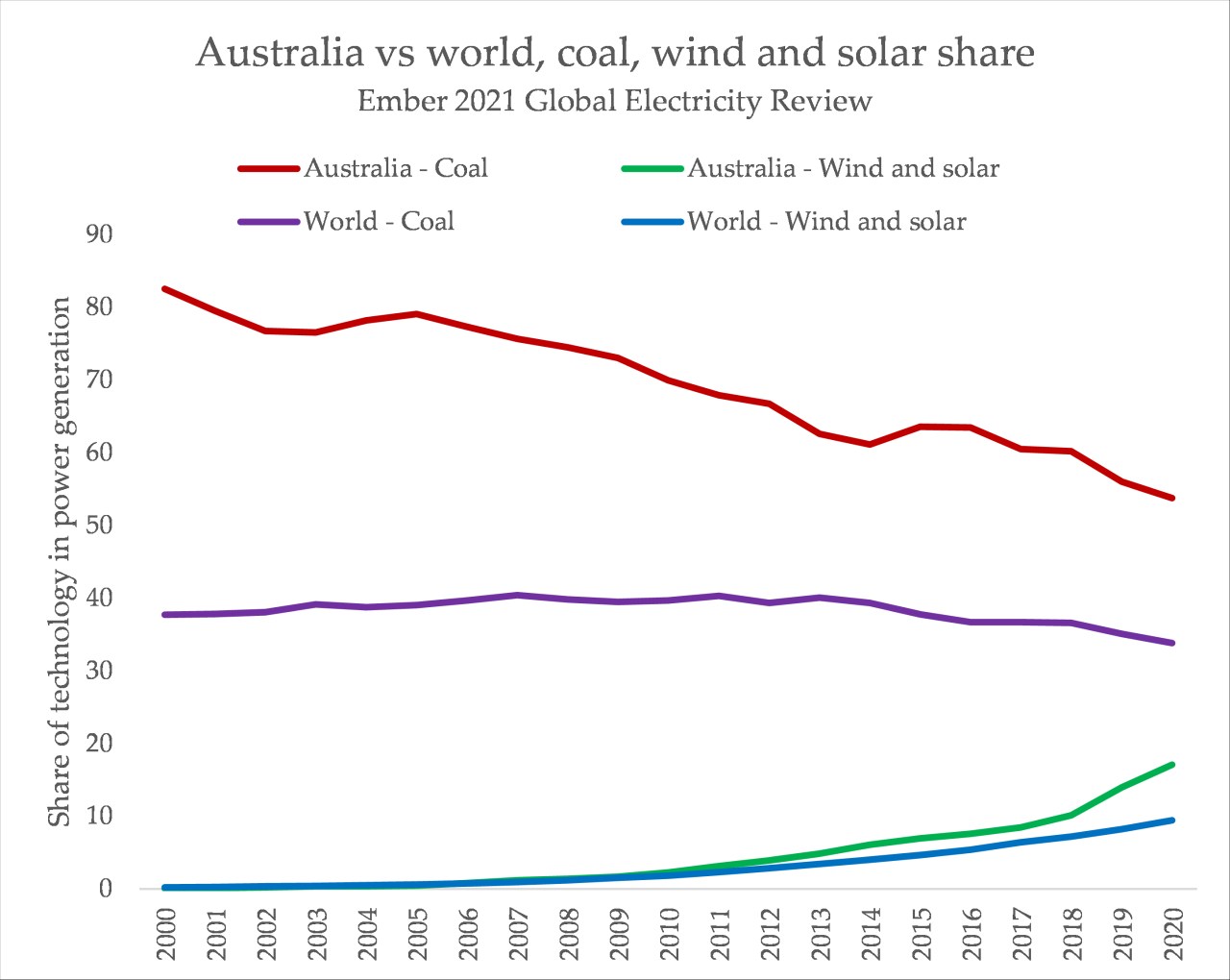Australia has retained its 10th place ranking on the list of top countries burning coal for power, as revealed in a new analysis by analytics firm Ember. This is despite record growth in renewable energy and in direct contradiction of the Australian government’s recent insistence that it is leading the world in decarbonising its power sector.
This is because, as RenewEconomy recently explored, Australia is developing renewable energy off a very low base, it has a high per-capita energy consumption, and does not feature ‘middle’ resources such as nuclear, biomass or relatively significant amounts of pumped hydro.
From 2015 to 2020, Australian coal shifted from 64% of total generation to 54%. However, in that time, coal’s share in the world’s electricity shifted from 38% to 34%, demonstrating Australia is far behind.
The analysis considers the absolute generation of coal power in each country, which is of course higher for countries with a high population. However, of the top 10 countries, Australia has the fifth highest share of coal of total power generation, at 54%. The highest is South Africa, at 86% and the lowest is Russia, at 15%.
The data from the 2021 edition of the Ember global electricity review, which showed that 2020 saw record growth in renewable energy, which proved resilient to the pandemic, but that needs to be both maintained and accelerated in a short time frame to begin substantially displacing fossil fuels around the world.
“Progress is nowhere near fast enough. Despite coal’s record drop during the pandemic, it still fell short of what is needed. Coal power needs to collapse by 80% by 2030 to avoid dangerous levels of warming above 1.5 degrees. We need to build enough clean electricity to simultaneously replace coal and electrify the global economy. World leaders have yet to wake up to the enormity of the challenge.” said Dave Jones, global programme lead at Ember.
Their data show that of the top fifteen countries by energy consumption, Australia, which ranks fifteenth, only reduced its coal power proportion from 2015 by 15%. The United Kingdom saw a drop of 92%, the United States saw 42% and Germany saw a fall of 44%.
“The five year trend reveals that coal power is in decline across many OECD coal countries, including the United States, Japan, Australia, Germany and Canada. But these OECD countries need to accelerate their coal exit to hit the 2030 deadline required to keep a chance of limiting global heating to 1.5C. Australia in particular still relies on coal power for 54% of its electricity”, said Ember, in their analysis.
Yesterday, the US-based Berkeley Lab released a deep dive into how the US has managed to reduce its share of coal significantly over the past several years. Unfortunately, much of the coal has been dispalced by fossil gas, which will be difficult to retire in time for President Biden’s clean power targets, but renewable energy did exceed the projections for 2020, published in 2005:
And as demand stayed flat, cheaper natural gas from the shale gas revolution combined with the rapid growth of wind and solar power to squeeze out coal. Some nuclear retirements were offset by greater output at existing plants. 3/11 pic.twitter.com/7Hhlq6HxgR
— EMP at Berkeley Lab (@BerkeleyLabEMP) April 13, 2021
Of the various technologies, in the report, coal’s actual output differed most from the 2005 expectations for 2020, with coal output 1,720 gigawatt hours lower than predicted. Renewables were 369 gigawatt hours higher than predicted.
The report also found that the increase in jobs from renewable energy far exceeded previous projections. The US power sector is now ‘halfway to zero’, but faces a range of significant challenges in fully removing fossil fuels from grids, such as decommissioning fossil infrastructure and rapidly building new renewables.
In recent months, Australia’s government has been advocating for its record on climate internationally by focusing on renewable energy growth, in the lead-up to COP26. However, it continues to receive strong criticism for lacking ambition, with the country’s emissions data showing insufficient change save for the impacts of renewable energy growth and the pandemic.













